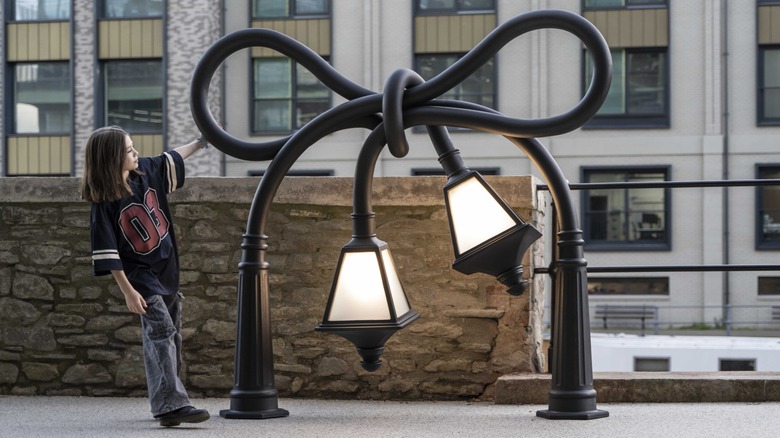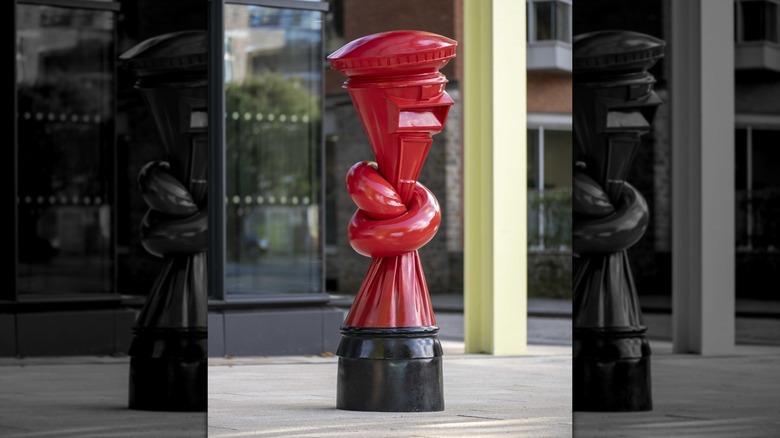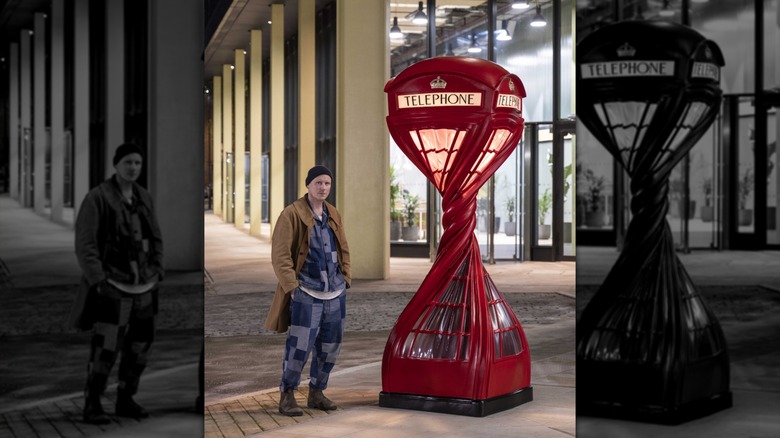A Playful Public Art Installation In Bristol Introduces 'Surrealism Into The Public Realm'
Positioned along the waterfront in Bristol, one of the more affordable European cities with fewer crowds, is an unexpected find: a larger-than-life art installation that shows common objects — with a surprising twist. Created by British artist Alex Chinneck, this project consists of three sets of sculptures that playfully disrupt the world around its visitors, if only for a moment. All of his monumental pieces, described as "street furniture," are designed to playfully weave "moments of surrealism into the public realm," as he tells Dezeen. This can be seen in his previous work too, where he has melted bricks, unzipped buildings, bent walls, and made cars surf. Over the last decade, Chinneck has created around 30 publicly displayed works of art, and he continues to push the boundaries between the familiar and fantasy, the ordinary and extraordinary, and reality and illusion.
Chinneck is also a proponent of making art widely available in public spaces, as these installations can have positive impacts: They can be moving, inspiring, or thought-provoking; they can elevate people's experience or impression of a place; and, like in the case of these awe-inspiring portals, they can allow visitors to travel the globe via livestream. Chinneck believes that art should not be restricted to galleries, viewed only by those who specifically come to visit them. Instead, open spaces can be made "far more interesting and dynamic ... with the introduction of public art," he explains.
The three sets of sculptures are all permanent pieces created for Assembly Bristol, a workspace and park, as part of its new public art trail. They are free to visit. If you are planning a trip to Bristol, England, stop by the waterfront and spend some time with these playful re-imaginings of everyday objects.
Alex Chinneck's trio of projects for Assembly Bristol
"First Kiss at Last Light" features two sculptures, one of which is pictured above (first image). Both are stylized, knotted Victorian-era lampposts created from cast steel and painted black. In one, the posts are tied in an elegant bow, weighing well over 650 pounds. In the other, the posts are intertwined, as if embracing — hence the project's apt name. They are surrealist art and street furniture in one, but they also act as functional lighting: In the evening, they turn on to illuminate the dark night streets with a soft, warm glow.
"Alphabetti Spaghetti" (second image) is a fire-engine red sculpture recognizable to anyone in the U.K. as a typical British postbox — but made less typical by the playful knot in its center. The color is meant to complement the brightly painted steel girders of Assembly Bristol behind it, as well as the street's cobblestones. This design was featured in a temporary art installation in various cities and towns around the U.K. in 2019, but it is now set up here permanently.
"Wring Ring" (pictured in the last image), which rounds out the trio, was perhaps the most challenging for Chinneck to craft due to its design. The same bright red as "Alphabetti Spaghetti," this structure will be familiar too — it is the iconic British telephone box. Fittingly, this internationally recognizable emblem of Britain celebrated its 100 years of existence in 2024, the same year Chinneck's piece was installed. The bronze-casted sculpture gets its name from its distorted appearance, which is similar to that of a towel being wrung out. It twists 720 degrees, with both the metal frame and glazed windows rippling around the twisted form. Like his two lamppost sculptures, this piece also lights up in the evening.
Visiting the sculptures, Bristol, and beyond
The sculptures can be seen by following Cheese Lane down to the walkway on the Floating Harbour wall. "Alphabetti Spaghetti" is located at the entrance of Cheese Lane from Narrow Plain — and the piece was placed there to mark the lane's re-opening to the public after 50 years. "Wring Ring" can be found in front of Assembly Bristol's Building A, which is currently home to the Bristol hub of the U.K.-based BT telecommunications company. The two designs for "First Kiss at Last Light" can be found at the waterfront, along the Floating Harbour wall. The entire art trail is around 500 feet long and can be walked in about three minutes. But don't rush — take the time to explore and thoroughly reflect on each evocative piece. Afterward, you can enjoy the view of the harbor and the River Avon flowing through it.
Plan to stay a few days in Bristol, as the city has a multitude of attractions, both indoor and outdoor, for visitors of all ages. If you haven't yet gotten your fill of awe-inspiring artwork, head to the three-floor Bristol Museum and Art Gallery, which is free and has exhibits covering everything from Egyptian mummies and dinosaurs to paintings by legendary European masters. Take an hour-long guided tour of the Clifton Suspension Bridge to learn more about its history and design. Or explore Cheddar Gorge, with its dramatic cliffs and subterranean caves filled with stalactites and stalagmites.
If you have time during your trip to explore the surrounding area, the city of Bath is well worth a stop and is just 12 minutes away from Bristol by train. Make sure to visit the spectacular Roman baths, a UNESCO World Heritage Site, and one of the best-preserved ancient complexes in Europe.


